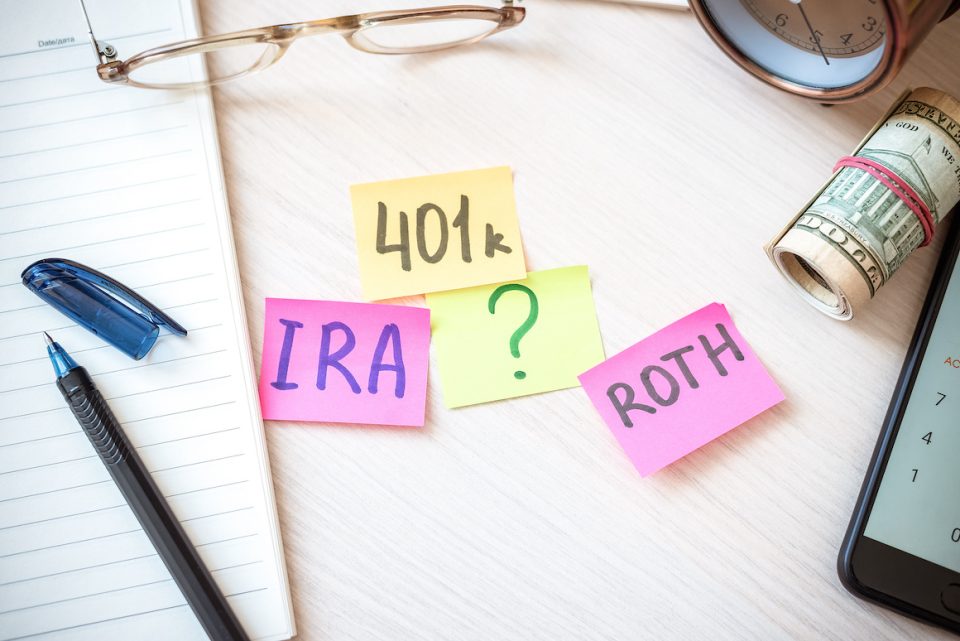Financial services company Empower says there are 937,747 Americans who are 401(k) millionaires – up 18% from last year. The average balance in these accounts is $1.14 million.
But author and retirement tax expert Ed Slott has a warning for those millionaires: many aren’t really millionaires. Or at least you won’t be once you pay your taxes.
In his Book, “The Retirement Savings Time Bomb,” Slott warns that there is a tax trap awaiting millions of people with traditional IRAs and 401(k)s. His warnings intensified in his new book, published in June, “The Retirement Savings Bomb Ticks Louder.”
Slott, named the “Best Source for IRA Advice” by the Wall Street Journal, says the problem, or “tax trap,” is that people tend to forget that traditional retirement accounts are “tax-deferred,” not tax free. “Remember, all of this money has not yet been taxed in IRAs and 401(k)s,” he says.
The taxes for many will begin when you start making withdrawals, which are now required once the accountholder turns 73. But many people begin withdrawals earlier. Those taxes can be thousands of dollars, depending on your tax bracket. In anticipation, some 401(k) plan administrators automatically withhold 20% of withdrawals to cover those unpaid taxes.
Withdrawals from these retirement accounts are taxed as ordinary income, in addition to other income you have in that year. Historically, it has been assumed that withdrawals from IRAs and 401(k)s would be made after retirement, when your income would be lower. But today, people are living longer and working longer, so that isn’t always the case.
The Answer: Convert to Roth Accounts
Slott’s answer is to begin converting those traditional IRAs and 401(k) to Roth accounts.
Traditional retirement accounts are tax-deferred, which means the account holder doesn’t pay taxes until he makes a withdrawal. There are also tax advantages for contributions.
With a Roth, you contribute after-tax dollars. There are no current-year tax benefits, but your contributions and earnings can grow tax-free. And you can withdraw them tax-free and penalty free after age 59½ and once the account has been open for five years.
That brings us to the key in Slott’s strategy. He says, “always pay taxes at the lowest rate.” And for many, that means begin converting those traditional tax-deferred accounts to Roth accounts.
“It’s very simple,” Slott says. “It’s like getting taxes on sale. Everybody likes a sale in a store. Look at Black Friday. They trample people to death to save $10 on a TV or something. The difference is, the sale on something in the store, you don’t actually have to buy that thing. But with taxes, you do. It’s not if, but when, these taxes will have to be paid. So, you may as well get them on sale, which is right now.”
Adding to that urgency is the fact that the Tax Cut and Jobs Act of 2017 expires next year. That law featured lower tax brackets and a lower standard deduction. Historically, U.S. Tax rates have been much higher. Slott points to a chart in his book that shows the nation’s top tax rates were as high as 91% the 1960s and 70% in the 1970s
There are incentives to encourage people to save for retirement in tax-deferred accounts. But the government wants you to eventually to pay those deferred taxes. So, they require you to begin withdrawals, called Required Minimum Distributions, or RMD. The RMD age requirement had been 70½ since 1986. The age was increased to 72 with the SECURE Act in 2019 and increased again to 73 with SECURE Act 2.0 in 2023.
But Slott says if you wait until you turn 73 to begin thinking about those withdrawals, you are no in longer control of your tax destiny.
“You want to be able to control the taxes you pay,” he says. “That’s how you can manage your tax bill to keep more money in retirement. You can do that by taking money out now, even if you don’t have to, just to maximize to take advantage of those low bracket rates and then move it to Roth IRAs. If you don’t need it this is the way to grow income tax free for the rest of your life.”
Penalties for not taking your RMD or taking less than required are severe. They were up to 50% of the amount or your RMD. That maximum penalty was reduced to 25% in the Secure Act 2.0.
Slott’s advice: “Pay taxes now at, today’s low rates. Why doesn’t everybody do it? Because most people are short sighted. Nobody wants to pay a tax before they’re forced to. But if you take that point of view, you lose control, and then you have bigger tax bills in retirement. Every day that your IRA grows, part of it is growing for the Uncle Sam. I always say in my seminars, your IRA is a debt. Your IRA is an IOU to the IRS.”
YOUR TURN
Are you prepared for the retirement tax bomb? Share your thoughts in the comments!
 Rodney A. Brooks is an award-winning journalist and author. The former Deputy Managing Editor/Money at USA TODAY, his retirement columns appear in U.S. News & World Report and Senior Planet.com. He has also written for National Geographic, The Washington Post and USA TODAY and has testified before the U.S. Senate Special Committee on Aging. His book, “The Rise & Fall of the Freedman’s Bank, And Its Lasting Socio-economic Impact on Black America” was released in 2024. He is also author of the book “Fixing the Racial Wealth Gap.” His website is www.rodneyabrooks.com
Rodney A. Brooks is an award-winning journalist and author. The former Deputy Managing Editor/Money at USA TODAY, his retirement columns appear in U.S. News & World Report and Senior Planet.com. He has also written for National Geographic, The Washington Post and USA TODAY and has testified before the U.S. Senate Special Committee on Aging. His book, “The Rise & Fall of the Freedman’s Bank, And Its Lasting Socio-economic Impact on Black America” was released in 2024. He is also author of the book “Fixing the Racial Wealth Gap.” His website is www.rodneyabrooks.com
Your use of any financial advice is at your sole discretion and risk. Seniorplanet.org and Older Adults Technology Services from AARP makes no claim or promise of any result or success.





COMMENTS
10 responses to “The Retirement Savings Tax Bomb”
So RMD is now 73. What is that formula again?
You can Google tax rates for 24’ to determine how much you pay IRS in Taxes with a Roth Conversion. But IRMMA for Medicare? And taxes on Social Security? Do we need a Tax planner ? There sure is a lot to look at and be smart with our hard earned dollars. Thanks
Here is what is guaranteed with a Roth conversion:
– RMD relief
– More flexibility for your heirs
– You lock in the tax rate that you are paying on the amount you are converting from your traditional IRA.
– You have access to a positive emotional state with your tax free Roth
But a guaranteed higher return on your initial investment is not one of them. Roth conversions are being way oversold. The benefits are totally dependent on long term future tax policy, which is unknown (last I looked).
A bigger issue than the income tax that must be paid on withdrawals from IRA and 401(k) accounts is the jolt tha occurs to a surviving spouse when one member of a married couple dies. When my husband died five years ago, my tax status went from “married filing jointly” to “single.” His IRA and 401(k) accounts were rolled over to mine, so I had to pay much higher taxes on what was essentially the same income. This phenomenon is ignored much too often in articles about taxes paid in retirement
I wish your article had pointed out that contributions to Roth IRA’s are limited both in the amount that can be contributed each year and who can participate.
It is true that Roth contributions are limited. But Roth conversions are not, except that you can only do ONE a year. And they are taxable (as income as the article points out).
So when you convert, make sure you get the right amount that won’t lift you into a higher tax bracket, trigger IRMAA (extra Medicare fees), or cause your Social Security to be taxed.
When you do a conversion, you have to pay taxes on that amount — yes or no?
Yes. Taxable as income. They also can trigger Medicare IRMAA charges etc..
Yes and those higher IRMAA rates stick with you for 2 years, even if your taxable income drops the next year if I understand the evaluation process. They look at your taxable income in the two years prior to present
It’s worth considering the impact of. moving oneself into a higher tax bracket when making a ROTH conversion.
It is also worth considering that when you convert to a Roth, your income will increase and thereby may cause you to pay higher Medicare premiums under the “IRMA” rules.
Sign Up for Newsletters
There’s always a lot going on in the Senior Planet universe. Get our newsletters to make sure you never miss a thing!
Sign Up Now
Join Senior Planet Community
Senior Planet Community is our social media platform designed specifically for older adult users. Engage in thought-provoking discussions, make new friends, and share resources all on a safe and ad-free platform.
Join the Conversation Today
Upcoming Online Classes
Calendar of Events
S Sun
M Mon
T Tue
W Wed
T Thu
F Fri
S Sat
0 events,
8 events,
Good Morning, Senior Planet!
Good Morning, Senior Planet!
Start your week off right with a preview of the week's upcoming programs and a guided meditation session!
Morning Stretch
Morning Stretch
Start your day with a short morning stretch!
Functional Strength Training
Functional Strength Training
Use bodyweight, bands, and dumbbells to build your strength.
Graphic Design Tools
Graphic Design Tools
In this presentation, we'll explore the popular design platform, Canva, and demonstrate how you can get very creative with basic tools like Google Slides.
Open Discussion – Lunch & Learn
Open Discussion – Lunch & Learn
Join this discussion group to connect with Senior Planet participants from all over the country!
5 events,
31
Morning Stretch
Morning Stretch
Start your day with a short morning stretch!
AI Voice & Video Generators
AI Voice & Video Generators
Did AI do that? Come learn about AI voice and video tools!
AI 人工智能簡介
AI 人工智能簡介
快來和 ChatGPT 聊天,了解 A.I.!
Tuesday Talks – Lunch & Learn
Tuesday Talks – Lunch & Learn
Hear from a Senior Planet participant about how technology is playing a beneficial role in their life!
Introduction to Booking Vacation Stays Online
Introduction to Booking Vacation Stays Online
Need a vacation? Learn about popular websites and apps for booking vacation rentals.
0 events,
1
6 events,
2
Morning Stretch
Morning Stretch
Start your day with a short morning stretch!
Cloud Storage
Cloud Storage
Registration required.
Learn the basics of cloud storage — a technology that lets you store documents, images, and other media files remotely.
Strength and Stability
Strength and Stability
Maintain your independence by staying strong and stable!
Tech Discussion Group – Lunch & Learn
Tech Discussion Group – Lunch & Learn
Come discuss different topics related to the latest technology trends and news.
Death Cafe
Death Cafe
Join this session to engage in meaningful conversation about death in a safe and open environment.
5 events,
3
Morning Stretch
Morning Stretch
Start your day with a short morning stretch!
Usos cotidianos de la IA
Usos cotidianos de la IA
¡Todo el mundo habla de IA! Asista a esta clase para ver cómo la IA es parte de la vida cotidiana.
Is That AI?
Is That AI?
Can we really believe what we see? Come to this class to train your eye to recognize AI!
Aging Discussion Group – Lunch & Learn
Aging Discussion Group – Lunch & Learn
Join this Aging Discussion Group to have open conversations about aging.
Smartphones at a Glance
Smartphones at a Glance
Registration required.
How smart are they? We'll tell you all about smartphones.
0 events,
4
0 events,
5
13 events,
6
Good Morning, Senior Planet!
Good Morning, Senior Planet!
Start your week off right with a preview of the week's upcoming programs and a guided meditation session!
Morning Stretch
Morning Stretch
Start your day with a short morning stretch!
Protecting Your Personal Info Online
Protecting Your Personal Info Online
Registration required.
Learn how to stay safe while you surf the web!
Functional Strength Training
Functional Strength Training
Use bodyweight, bands, and dumbbells to build your strength.
Fit Fusion Workout
Fit Fusion Workout
Get your heart pumping during this fun, high-energy workout!
15 events,
7
Stronger Bones
Stronger Bones
Activate the joints and muscles and increase mental focus during this exercise class.
Morning Stretch
Morning Stretch
Start your day with a short morning stretch!
Ridesharing Apps
Ridesharing Apps
Registration required.
No car? No problem! Use these apps to help you get around!
All Things Zoom
All Things Zoom
This lecture will go over how to use Zoom to chat with friends & family, and take virtual classes with Senior Planet!
Introduction to A.I.
Introduction to A.I.
Registration required.
Come chat with ChatGPT and learn about A.I.!
13 events,
8
Morning Stretch
Morning Stretch
Start your day with a short morning stretch!
Virtual Tour: Naples, Italy
Virtual Tour: Naples, Italy
Join Senior Planet and our tour guides from Discover Live for a virtual visit to Naples, Italy!
Fit Fusion Workout
Fit Fusion Workout
Get your heart pumping during this fun, high-energy workout!
與 AI 聊天的介紹
與 AI 聊天的介紹
學習如何完全發揮 ChatGPT 和其他 AI 軟體的功能。
Intro to X (formerly Twitter)
Intro to X (formerly Twitter)
Like to know what's happening? Come learn about X (formerly Twitter)!
12 events,
9
Balance/Strength
Balance/Strength
Activate the joints and muscles to become limber and increase balance during this exercise class.
Morning Stretch
Morning Stretch
Start your day with a short morning stretch!
Mobile Health Apps
Mobile Health Apps
Registration required.
This lecture introduces common health apps, like the iPhone's built-in app and the Google Fit app.
Introduction to Social Media
Introduction to Social Media
Social media is everywhere these days. We'll introduce you to the most popular platforms!
Digital Legacy at a Glance
Digital Legacy at a Glance
Will your digital content and social media pages live on forever? Come learn about your digital legacy options!
11 events,
10
Qigong Flow
Qigong Flow
Join this special class that combines gentle movement with a focus on harmonizing your mind, body and breath.
Morning Stretch
Morning Stretch
Start your day with a short morning stretch!
Programas de antivirus y eliminación de malware de un vistazo
Programas de antivirus y eliminación de malware de un vistazo
¿Le preocupan los virus y el malware? ¡Asista a esta presentación para aprender cómo mantener su dispositivo seguro!
Fitness Apps
Fitness Apps
Registration required.
Learn how fitness apps can help you track and conquer your goals!
Taijiquan (Tai Chi)
Taijiquan (Tai Chi)
Relax your mind and strengthen your body with this gentle exercise class.
4 events,
11
Functional Strength Training
Functional Strength Training
Use bodyweight, bands, and dumbbells to build your strength.
Digital Scrapbooking Tools
Digital Scrapbooking Tools
Say goodbye to paper cuts! Come learn about digital scrapbooking tools.
Digital Storytelling
Digital Storytelling
This lecture covers digital tools to bring out your creativity.
Graphic Design Tools
Graphic Design Tools
In this presentation, we'll explore the popular design platform, Canva, and demonstrate how you can get very creative with basic tools like Google Slides.
0 events,
12
13 events,
13
Good Morning, Senior Planet!
Good Morning, Senior Planet!
Start your week off right with a preview of the week's upcoming programs and a guided meditation session!
Morning Stretch
Morning Stretch
Start your day with a short morning stretch!
Digital Tools to Boost your Business
Digital Tools to Boost your Business
Learn about online tools to jump-start your start-up.
Functional Strength Training
Functional Strength Training
Use bodyweight, bands, and dumbbells to build your strength.
Fit Fusion Workout
Fit Fusion Workout
Get your heart pumping during this fun, high-energy workout!
14 events,
14
Stronger Bones
Stronger Bones
Activate the joints and muscles and increase mental focus during this exercise class.
Morning Stretch
Morning Stretch
Start your day with a short morning stretch!
Reddit at a Glance
Reddit at a Glance
Stumped? Find what you're looking for on Reddit!
Spotify
Spotify
In this lecture, you'll learn about Spotify’s important features, including how to search for songs and create your own playlists.
Everyday Uses of AI
Everyday Uses of AI
Registration required.
Everyone is talking about AI! Come to this class to see how AI is part of everyday life.
11 events,
15
Morning Stretch
Morning Stretch
Start your day with a short morning stretch!
Anti-Virus & Malware Removal Programs At a Glance
Anti-Virus & Malware Removal Programs At a Glance
Registration required.
Concerned about viruses and malware? Attend this lecture to learn how to keep your device safe!
AI 的日常用途
AI 的日常用途
大家都在談論 AI!參加本課程,看看 AI 在日常生活中扮演什麼角色。
Fit Fusion Workout
Fit Fusion Workout
Get your heart pumping during this fun, high-energy workout!
Understanding Internet Plans
Understanding Internet Plans
Faster is not always better! Come learn about home internet options so you only pay for what you need.
13 events,
16
Balance/Strength
Balance/Strength
Activate the joints and muscles to become limber and increase balance during this exercise class.
Morning Stretch
Morning Stretch
Start your day with a short morning stretch!
Affordable Home Internet
Affordable Home Internet
Registration required.
Don't overpay for internet. Learn about programs offering low-cost home internet that can help save you money.
Internet of Things: Entertainment
Internet of Things: Entertainment
This lecture will explore the many ways we interact with IoT on a day-to-day basis and take a look at how it’s revolutionizing entire industries.
Streaming & Smart TVs
Streaming & Smart TVs
This presentation will introduce streaming: what it is, how to use it, and the variety of content available.
11 events,
17
Qigong Flow
Qigong Flow
Join this special class that combines gentle movement with a focus on harmonizing your mind, body and breath.
Morning Stretch
Morning Stretch
Start your day with a short morning stretch!
IoT: Smart Homes
IoT: Smart Homes
Want to live like the Jetsons? Learn how smart home technology is making that a reality!
Almacenamiento en la nube
Almacenamiento en la nube
Aprenda por qué va a querer empezar a usar servicios del almacenamiento en la nube en su vida diaria con sus archivos, imágenes, y documentos.
Taijiquan (Tai Chi)
Taijiquan (Tai Chi)
Relax your mind and strengthen your body with this gentle exercise class.
3 events,
18
Online Travel Sites
Online Travel Sites
Learn the basics of using online travel sites to find the best fares and rates for just about any destination.
Introduction to Booking Vacation Stays Online
Introduction to Booking Vacation Stays Online
Need a vacation? Learn about popular websites and apps for booking vacation rentals.
Intro to Translation Tools
Intro to Translation Tools
This lecture will introduce digital translation tools and apps, such as Google Translate.
0 events,
19
0 events,
20
14 events,
21
Stronger Bones
Stronger Bones
Activate the joints and muscles and increase mental focus during this exercise class.
Morning Stretch
Morning Stretch
Start your day with a short morning stretch!
Protecting Your Personal Info Online
Protecting Your Personal Info Online
Registration required.
Learn how to stay safe while you surf the web!
Tips for Being News Savvy Online
Tips for Being News Savvy Online
Sharing the news? Learn to read and check sources before sharing!
AI & Disinformation
AI & Disinformation
Registration required.
Seeing might not mean believing anymore. Come learn how to identify deepfakes and cloned voices so you don't fall for digital deception.
11 events,
22
Morning Stretch
Morning Stretch
Start your day with a short morning stretch!
How to Choose a New Computer
How to Choose a New Computer
Registration required.
This informational session addresses some of the most common questions surrounding how to choose a new computer.
Fit Fusion Workout
Fit Fusion Workout
Get your heart pumping during this fun, high-energy workout!
那是 AI 做的嗎?
那是 AI 做的嗎?
我們真的能「眼見為憑」嗎?來這堂課鍛鍊出能辨別 AI 影像的火眼金睛!
Virtual Museum Tours
Virtual Museum Tours
In this lecture we'll explore some of these virtual galleries, as well as digital tools that help bring art, architecture, and history to life!
13 events,
23
Balance/Strength
Balance/Strength
Activate the joints and muscles to become limber and increase balance during this exercise class.
Morning Stretch
Morning Stretch
Start your day with a short morning stretch!
Google Maps
Google Maps
Registration required.
During this lecture, you’ll get an introduction to Google Maps and a demonstration of how to use it.
Introduction to Nextdoor
Introduction to Nextdoor
This presentation will introduce you to the most common uses for the Nextdoor app and its main features, along with some best practices for using it safely.
Introduction to Estate Planning Resources & Tools
Introduction to Estate Planning Resources & Tools
Registration required.
A simple plan is better than no plan! Get to know a few free and low-cost resources that make it simple to plan your estate.
11 events,
24
Qigong Flow
Qigong Flow
Join this special class that combines gentle movement with a focus on harmonizing your mind, body and breath.
Morning Stretch
Morning Stretch
Start your day with a short morning stretch!
Voice Assistants
Voice Assistants
Learn about the many devices, current uses, and future implications of this exciting technology.
Mapas de Google
Mapas de Google
Aprenda cómo puede ver mapas y navegar a lugares nuevos con una aplicación y el internet en esta presentación de Google Maps.
Taijiquan (Tai Chi)
Taijiquan (Tai Chi)
Relax your mind and strengthen your body with this gentle exercise class.
1 event,
25
Morning Stretch
Morning Stretch
Start your day with a short morning stretch!
0 events,
26
14 events,
27
Good Morning, Senior Planet!
Good Morning, Senior Planet!
Start your week off right with a preview of the week's upcoming programs and a guided meditation session!
Morning Stretch
Morning Stretch
Start your day with a short morning stretch!
Introduction to Sleep Technologies
Introduction to Sleep Technologies
Registration required.
Learn about devices and apps that can help you get more Zzz's
Functional Strength Training
Functional Strength Training
Use bodyweight, bands, and dumbbells to build your strength.
Fit Fusion Workout
Fit Fusion Workout
Get your heart pumping during this fun, high-energy workout!
14 events,
28
Stronger Bones
Stronger Bones
Activate the joints and muscles and increase mental focus during this exercise class.
Morning Stretch
Morning Stretch
Start your day with a short morning stretch!
Spotify
Spotify
In this lecture, you'll learn about Spotify’s important features, including how to search for songs and create your own playlists.
Internet of Things: Wearables
Internet of Things: Wearables
Registration required.
Learn about the health, wellness, and personal safety benefits of wearable technology.
AI All Around
AI All Around
Never fear, for AI is here... to (try to) help!
10 events,
29
Morning Stretch
Morning Stretch
Start your day with a short morning stretch!
Fit Fusion Workout
Fit Fusion Workout
Get your heart pumping during this fun, high-energy workout!
AI 影像創作器
AI 影像創作器
別再畫火柴人了,快用 AI 影像創作器,把您的想像化作現實圖片!
Video Chat
Video Chat
In this lecture, you’ll find out about some commonly-used, no or low-cost video chat apps, learn about their features, and explore video chat tips so you can present your best self when on a video chat.
Easy-to-Follow Tai Chi
Easy-to-Follow Tai Chi
Move, breathe and flow during this gentle, slow, flowing form of exercise
12 events,
30
Balance/Strength
Balance/Strength
Activate the joints and muscles to become limber and increase balance during this exercise class.
Morning Stretch
Morning Stretch
Start your day with a short morning stretch!
Tips for Being News Savvy Online
Tips for Being News Savvy Online
Registration required.
Sharing the news? Learn to read and check sources before sharing!
Outdoor Adventure Apps
Outdoor Adventure Apps
Love the great outdoors? Come learn how smartphone apps can enhance your outdoor hobbies!
Job Searching in the Digital Age
Job Searching in the Digital Age
This lecture will provide an overview of how to use social media in your job search, demonstrate digital job searching tools like LinkedIn, and offer tips and advice to job seekers.
12 events,
31
Qigong Flow
Qigong Flow
Join this special class that combines gentle movement with a focus on harmonizing your mind, body and breath.
Morning Stretch
Morning Stretch
Start your day with a short morning stretch!
Espacio de trabajo de Google
Espacio de trabajo de Google
Su cuenta de Google es mucho más que solamente su correo electrónico. Le contaremos qué más puede hacer con su cuenta Google.
Intro to Photo Editing Tools
Intro to Photo Editing Tools
Can you photoshop that? Come learn the possibilities with photo editing tools!
Taijiquan (Tai Chi)
Taijiquan (Tai Chi)
Relax your mind and strengthen your body with this gentle exercise class.
0 events,
1
Good Morning, Senior Planet!
Morning Stretch
Functional Strength Training
Graphic Design Tools
Open Discussion – Lunch & Learn
Morning Stretch
AI Voice & Video Generators
AI 人工智能簡介
Tuesday Talks – Lunch & Learn
Introduction to Booking Vacation Stays Online
Morning Stretch
Cloud Storage
Strength and Stability
Tech Discussion Group – Lunch & Learn
Death Cafe
Morning Stretch
Usos cotidianos de la IA
Is That AI?
Aging Discussion Group – Lunch & Learn
Smartphones at a Glance
Good Morning, Senior Planet!
Morning Stretch
Protecting Your Personal Info Online
Functional Strength Training
Fit Fusion Workout
Stronger Bones
Morning Stretch
Ridesharing Apps
All Things Zoom
Introduction to A.I.
Morning Stretch
Virtual Tour: Naples, Italy
Fit Fusion Workout
與 AI 聊天的介紹
Intro to X (formerly Twitter)
Balance/Strength
Morning Stretch
Mobile Health Apps
Introduction to Social Media
Digital Legacy at a Glance
Qigong Flow
Morning Stretch
Programas de antivirus y eliminación de malware de un vistazo
Fitness Apps
Taijiquan (Tai Chi)
Functional Strength Training
Digital Scrapbooking Tools
Digital Storytelling
Graphic Design Tools
Good Morning, Senior Planet!
Morning Stretch
Digital Tools to Boost your Business
Functional Strength Training
Fit Fusion Workout
Stronger Bones
Morning Stretch
Reddit at a Glance
Spotify
Everyday Uses of AI
Morning Stretch
Anti-Virus & Malware Removal Programs At a Glance
AI 的日常用途
Fit Fusion Workout
Understanding Internet Plans
Balance/Strength
Morning Stretch
Affordable Home Internet
Internet of Things: Entertainment
Streaming & Smart TVs
Qigong Flow
Morning Stretch
IoT: Smart Homes
Almacenamiento en la nube
Taijiquan (Tai Chi)
Online Travel Sites
Introduction to Booking Vacation Stays Online
Intro to Translation Tools
Stronger Bones
Morning Stretch
Protecting Your Personal Info Online
Tips for Being News Savvy Online
AI & Disinformation
Morning Stretch
How to Choose a New Computer
Fit Fusion Workout
那是 AI 做的嗎?
Virtual Museum Tours
Balance/Strength
Morning Stretch
Google Maps
Introduction to Nextdoor
Introduction to Estate Planning Resources & Tools
Qigong Flow
Morning Stretch
Voice Assistants
Mapas de Google
Taijiquan (Tai Chi)
Morning Stretch
Good Morning, Senior Planet!
Morning Stretch
Introduction to Sleep Technologies
Functional Strength Training
Fit Fusion Workout
Stronger Bones
Morning Stretch
Spotify
Internet of Things: Wearables
AI All Around
Morning Stretch
Fit Fusion Workout
AI 影像創作器
Video Chat
Easy-to-Follow Tai Chi
Balance/Strength
Morning Stretch
Tips for Being News Savvy Online
Outdoor Adventure Apps
Job Searching in the Digital Age
Qigong Flow
Morning Stretch
Espacio de trabajo de Google
Intro to Photo Editing Tools
Taijiquan (Tai Chi)
Recent Articles
Recent Comments